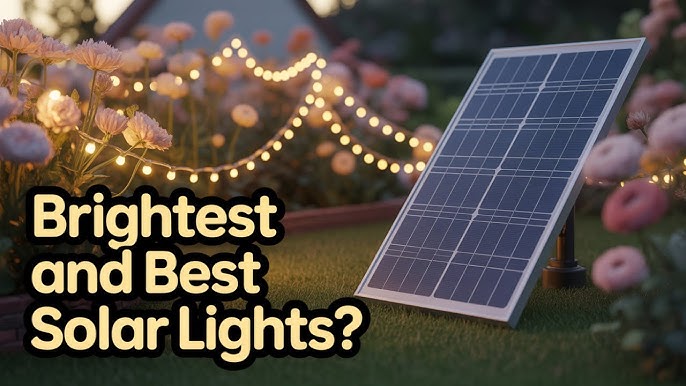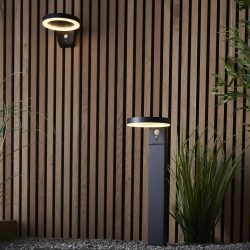Have you ever wondered how solar garden lights brighten up your outdoor space without any wires or electricity bills? Imagine stepping into your garden at night, greeted by soft, glowing lights that turn on all by themselves.
It’s not magic—it’s smart technology working quietly behind the scenes. You’ll discover exactly how these lights soak up the sun’s energy during the day and transform it into beautiful illumination after dark. Keep reading, and you’ll learn how solar garden lights work, why they’re a great choice for your home, and how to get the most out of them.
Your garden is about to shine like never before!

Credit: www.youtube.com
Basics Of Solar Garden Lights
Solar garden lights are a popular choice for outdoor lighting. They use sunlight to power LED bulbs at night. These lights are simple and save energy. Understanding how they work helps you use them better. Let’s explore the basics of solar garden lights.
Key Components
Solar garden lights have a few important parts. A solar panel collects sunlight during the day. A rechargeable battery stores this energy. An LED bulb uses the stored power to shine at night. A light sensor controls when the light turns on and off. These parts work together to provide light without wires.
Energy Conversion Process
The solar panel changes sunlight into electricity. This process is called energy conversion. The panel uses solar cells made of silicon. These cells create electric current from sunlight. The current charges the battery inside the light. At night, the battery sends power to the LED bulb. The light sensor tells the bulb when to glow. This cycle repeats every day without extra cost.
How Solar Panels Capture Sunlight
Solar panels in garden lights turn sunlight into power. They work by capturing sunlight and changing it into electricity. This process lets solar lights shine without wires or batteries from the store.
The key part of this is the solar panel itself. It holds special materials called solar cells. These cells catch sunlight and start the power-making process.
Types Of Solar Cells
Solar panels use different types of solar cells. The most common are monocrystalline and polycrystalline cells. Monocrystalline cells are made from a single crystal of silicon. They are efficient and work well in low light. Polycrystalline cells have many silicon crystals. They cost less but are a bit less efficient.
Another type is thin-film solar cells. These are light and flexible but less common in garden lights. Each type has its strengths depending on the light and cost needs.
Sunlight To Electricity
Solar cells change sunlight into electricity through the photovoltaic effect. Sunlight hits the solar cells and excites electrons. This movement of electrons creates an electric current. Wires in the panel collect this current and send it to a battery.
The battery stores electricity during the day. At night, it powers the garden lights. This cycle repeats every day, making solar garden lights eco-friendly and easy to use.
Role Of Rechargeable Batteries
Rechargeable batteries are the heart of solar garden lights. They store energy captured from sunlight during the day. At night, this stored energy powers the light. Without these batteries, solar lights would not work after sunset.
These batteries ensure the light stays on for hours. They help make solar garden lights reliable and eco-friendly. Choosing the right battery affects how well the light performs.
Battery Types Used
Most solar garden lights use either NiMH or Li-ion batteries. NiMH stands for Nickel-Metal Hydride. These batteries are affordable and safe. Li-ion means Lithium-ion. These batteries last longer and hold more energy.
NiMH batteries are common in budget lights. Li-ion batteries appear in higher-end models. Both types recharge many times before needing replacement.
Charging And Discharging Cycle
The battery charges during daylight hours. Solar panels convert sunlight into electricity. This electricity fills the battery with power. At night, the battery releases stored energy to light up the garden.
Each full charge and discharge is one cycle. Batteries have a limited number of cycles. The more cycles, the longer the battery lasts. Proper charging keeps the battery healthy and efficient.

Credit: www.moonlightdesign.co.uk
Light Sensors And Automation
Light sensors and automation are key features in solar garden lights. They make these lights smart and easy to use. These components allow the lights to work on their own, saving energy and effort.
Detecting Darkness
Solar garden lights have built-in sensors to detect darkness. These sensors sense the natural light outside. When the sun sets and it gets dark, the sensors react. They tell the light to turn on. This happens without any human help.
The sensors measure the amount of light in the environment. They work well even on cloudy days. This ensures the garden lights turn on only when needed. It prevents wasting energy during daylight.
Automatic On/off Function
The automatic on/off function is controlled by the light sensors. Once it gets dark, the lights switch on automatically. At dawn, when sunlight returns, the lights turn off.
This function helps save battery power. It also extends the life of the solar lights. You do not need to remember to switch the lights on or off. The automation does it all by itself.
Leds: The Light Source
Solar garden lights use small solar panels to collect sunlight and charge batteries during the day. At night, LEDs light up using the stored energy, providing soft and energy-efficient illumination. This simple process makes them easy to use and eco-friendly.
Solar garden lights use LEDs as their main light source. LEDs stand for Light Emitting Diodes. They are small but very bright lights that use little energy. LEDs convert electricity into light efficiently, which is perfect for solar lights powered by limited solar energy. Their size allows for various designs, making solar garden lights both functional and decorative.
Energy Efficiency
LEDs use much less power than traditional bulbs. This means solar panels can charge the batteries faster. Less energy use helps the lights stay on longer at night. LEDs produce light without much heat, saving energy that would be lost as heat. This efficiency makes solar garden lights reliable and eco-friendly.
Longevity And Brightness
LEDs last much longer than old-fashioned bulbs. They can shine for thousands of hours without losing brightness. This means fewer replacements and less waste. The light from LEDs stays steady and clear. Even after long use, they keep gardens well-lit and beautiful.

Credit: solarmagazine.com
Installation Tips For Maximum Efficiency
Installing solar garden lights correctly helps them work better and last longer. Proper setup ensures they absorb enough sunlight and shine brightly at night. Simple steps can improve their performance and save energy.
Optimal Placement
Place solar lights where they get direct sunlight. Avoid shaded spots under trees or near buildings. South-facing areas usually get the most sun. Keep lights away from objects that cast shadows. Make sure panels face the sun for better charging. Proper placement boosts light brightness and runtime.
Maintenance Practices
Clean solar panels regularly to remove dust and dirt. Use a soft cloth and mild soap with water. Dirty panels block sunlight and reduce power. Check batteries once a year and replace if needed. Trim plants that grow over the lights. Regular care keeps lights working at full capacity.
Common Issues And Troubleshooting
Solar garden lights brighten outdoor spaces without wiring. They use sunlight to charge batteries and power LEDs. Problems can stop them from working well. Troubleshooting helps find and fix these issues fast.
Battery Problems
Batteries store solar energy for night use. Over time, batteries lose their ability to hold charge. Old or damaged batteries cause lights to dim or fail. Replace batteries every 1-2 years for best results. Check battery placement for correct polarity. Dirty or corroded contacts can block power flow. Clean contacts with a soft cloth and mild cleaner.
Sensor Malfunctions
Sensors detect darkness to turn lights on. Dirt or debris on sensors can block light detection. Clean sensors gently with a damp cloth. Sensors may fail in shaded or obstructed areas. Place lights where sensors get direct sky view. Faulty sensors can cause lights to stay off or on. Test sensors by covering and uncovering them to see response.
Frequently Asked Questions
How Do Solar Garden Lights Charge During The Day?
Solar garden lights charge through built-in solar panels. These panels convert sunlight into electrical energy. The energy stores in rechargeable batteries. This powers the light during nighttime automatically.
What Type Of Batteries Do Solar Garden Lights Use?
Most solar garden lights use rechargeable NiMH or Li-ion batteries. These batteries efficiently store solar energy. They allow the light to work overnight. Battery type affects light duration and performance.
How Do Solar Garden Lights Turn On At Night?
Solar garden lights have light sensors called photodiodes. These sensors detect low light levels at dusk. They automatically switch the light on. This saves energy by operating only in darkness.
Can Solar Garden Lights Work On Cloudy Days?
Yes, solar garden lights can work on cloudy days. Though solar panels receive less sunlight, batteries still charge partially. Lights may have shorter illumination times but generally function well.
Conclusion
Solar garden lights use sunlight to power their bulbs at night. They store energy in batteries during the day. This process saves electricity and helps the environment. These lights turn on automatically when it gets dark. They are easy to install and need little care.
Using solar garden lights brightens your garden safely and cheaply. They work well in many outdoor spaces. Choosing solar lights means using clean, free energy. A simple way to add light and charm to your garden.
